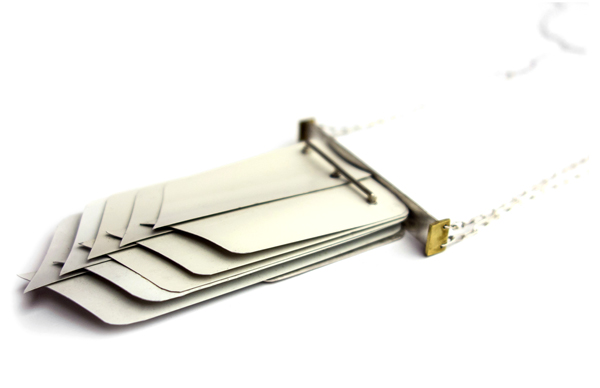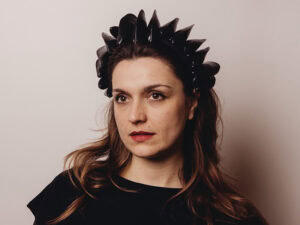
Courtney Kemp, who lives in Oregon, keeps both a jewelry and a sculpture practice. In her jewelry, she restructures mundane, domestic bits of living spaces into contemporary and precious wearables. She currently teaches at the Oregon College of Art and Craft and the University of Oregon.
Karen Vanmol, a jewelry artist based in Belgium, explores the tension between city and countryside as familiar childhood landscapes fade and as her understanding of the world is constantly “under construction.” This is her fourth time showing work at the Heidi Lowe Gallery.
Olivia Shih: Can you talk about your background and about how you found your way to making jewelry?
Courtney Kemp: Growing up, I was always excited about building and making. We lived on a farm that had been in my father’s family for years and was filled with really archaic architecture and machinery, so there was the consistent need for repairing and rebuilding. I fell into making jewelry in college without any prior experience or concrete knowledge about the field, but with a solid background in tinkering. I feel it was more the material itself that drew me in, rather than the format. The potentials of working with metal seemed endless.
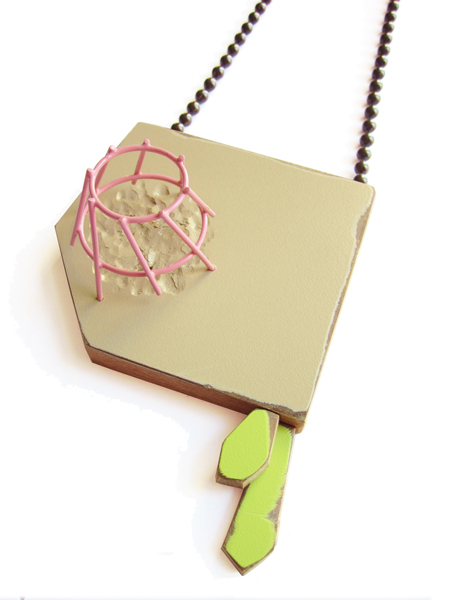
Courtney Kemp, who lives in Oregon, keeps both a jewelry and a sculpture practice. In her jewelry, she restructures mundane, domestic bits of living spaces into contemporary and precious wearables. She currently teaches at the Oregon College of Art and Craft and the University of Oregon.
Karen Vanmol, a jewelry artist based in Belgium, explores the tension between city and countryside as familiar childhood landscapes fade and as her understanding of the world is constantly “under construction.” This is her fourth time showing work at the Heidi Lowe Gallery.
Olivia Shih: Can you talk about your background and about how you found your way to making jewelry?
Courtney Kemp: Growing up, I was always excited about building and making. We lived on a farm that had been in my father’s family for years and was filled with really archaic architecture and machinery, so there was the consistent need for repairing and rebuilding. I fell into making jewelry in college without any prior experience or concrete knowledge about the field, but with a solid background in tinkering. I feel it was more the material itself that drew me in, rather than the format. The potentials of working with metal seemed endless.
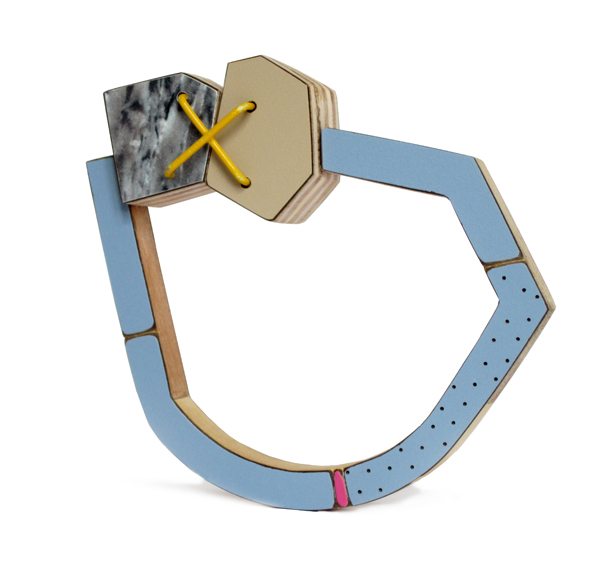
I was always drawn toward jewelry. When I was eight years old, a teacher at school wore a ring with pink and black stones, and I re-created that ring with wire and beads. While I was making this kind of jewelry, I wasn’t happy with it because it wasn’t “real.” I thought it was childish, and I never wore any of it. Later, I heard about a goldsmith training class at night school. For some unknown reason, it was very obvious to me that I was going to do this. I did it for two years and then took the leap to the Royal Academy of Fine Arts in Antwerp.
Why jewelry? What is it about jewelry that makes sense or doesn’t make sense to you?
Courtney Kemp: In conjunction with my sculptural practice, which tends to be large in scale and somewhat installation-based, the medium of jewelry allows me to focus on what I tend to feel is the “micro-environment” of my practice. I can really start to parse out the specifics in found materials in a manner that a larger structure would not allow: the way vinyl texture moves when heated, the color change if you start peeling layers of rubber, the shimmer in certain types of tile. The closeness of jewelry lets my wearer explore moments in architecture or in the domestic setting that may normally only exist in the frame of utility in their day-to-day life. I like the idea that all of a sudden your eye recognizes something special and lovely in these materials that exist in so many of your memories as background setting.
Karen Vanmol: That’s a difficult question; I’m not sure it was a “jewelry or nothing” choice for me. I do think that creating jewelry is more interesting and challenging because you have to consider a lot of things. I also like limited dimensions; I’m glad I don’t need a truck to transport my work, and that I can turn my work around in my hands during the making process.
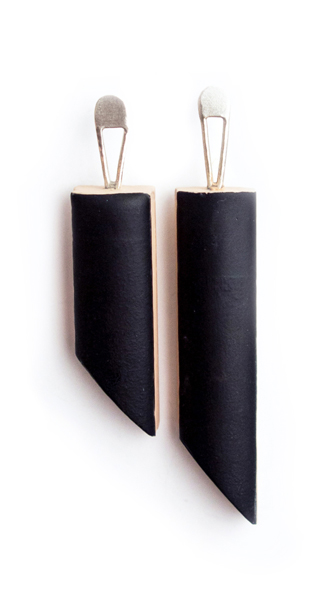
Courtney Kemp: That’s an interesting question. I think there’s a similar kind of engagement between the piece and the home it inhabits after it leaves my studio, and the piece and the body. That relationship really exists strictly for the owner, but I would be intrigued to have a glimpse of its life. It would be interesting to explore the similarities and differences between the materials and aesthetics of a necklace, for example, and the home it lives in with a buyer. The idea of someone tacking up a piece against some weathered wood paneling in their home or tossing it in a corner against dusty molding from the 40s is probably more exciting than it should be to me. I would love to see that clash of material and history.
Karen Vanmol: As a designer-maker, you know that when you create a work, at a certain point the outside world will come in, and you have to take a step back and share.
I’ve used materials from the house of my great–grandparents, but I often don’t tell people that. For other people it doesn’t mean a lot. It’s something that I’ve experienced and therefore has an impact on what I do.
I’ve met people who look at my work and think back to their childhoods because of a color or a material that I used. Sometimes they think of the negative things, things they aren’t very fond of, and these people will not take my work with them. If people project their own vision on my work and see positive things they would like to keep, I am happy for that.
Karen, you’ve stated that you find elements in your surroundings (such as at a nearby construction site, or in your grandfather’s kitchen done in bright-colored laminate), and you then “edit” these properties. Can you talk more about this editing process?
Karen Vanmol: I believe that I should understand my material, know how it works, what I can and can’t do with it. I do that in a theoretical way by searching for information. I use a lot of Formica (this is the original brand name for laminate); well, that wasn’t invented for use as a tabletop. And at the same time I do research in my workshop with the material. When I started working with the laminate, I thought that I wouldn’t use it for very long because I found it so difficult to work with. But these restrictions are exactly what makes it interesting. During my master’s study I worked with concrete; in a way I could shape it like I wanted so I lost interest soon after. Besides the material, there is the aspect of theme and the forms I use. I don’t want to make a literal story for every piece I make. A lot of different issues will come together in the work once it’s finished.
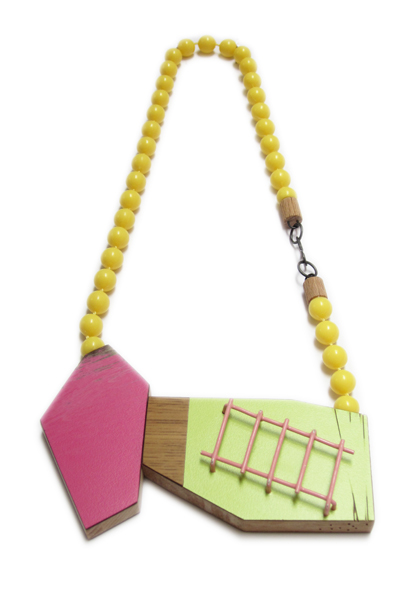
Courtney, you’ve stated that your jewelry integrates mundane, often household, objects onto our bodies as new wearables. What potential do you see in relocating domestic space onto the human body?
Courtney Kemp: While I love the medium of jewelry, the idea of the “body as site” doesn’t play into my work quite as strongly as it does for a lot of jewelers. I think it’s more about scale and reassessing the labels of decorative, structural, or useful. In my pieces of jewelry, you’re able to see the details in the architectural materials in a manner that allows you to explore them formally or with a personal narrative of touch and memory, rather than as pure utility. In essence, you wear an object that holds the recognition of a material or form that reminds you of something, a glimmer of a memory maybe. I’m drawn to working with narrative and the sense that certain materials can give you that “it’s on the tip of my tongue” feeling—slightly recognizable, tied to personal memories, but different somehow.
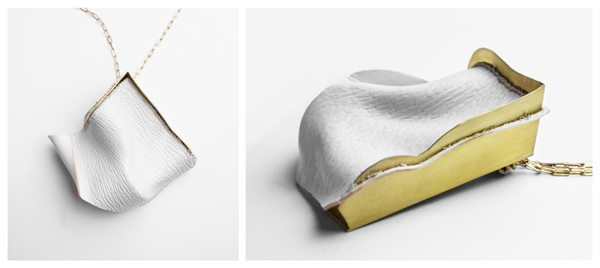
Many of our readers are in school or just graduating and have no idea how to continue doing what they love. Do you make your living by making? How is that going, and what are your biggest challenges?
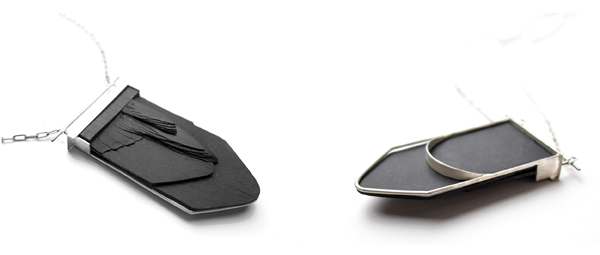
The moment you step out of your workshop with the work, you have a business. And you can make great work but if you’re bad with deadlines and you have a difficult time organizing yourself, it won’t be easy. These are things you often have to learn after graduating.
Have you read, seen, or heard anything interesting or stimulating recently?
